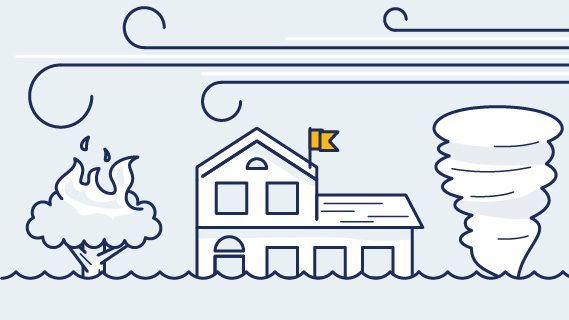As we approach the end of 2024 and look back on the year, it’s clear that severe weather across the United States has become increasingly unpredictable. From raging wildfires and record-breaking hurricanes to devastating floods, the impact of these natural disasters has been felt by communities across the country. The financial burden imposed on families and businesses is growing heavier, which has influenced insurance trends and shed light on new considerations for financial planning. In this blog post, we’ll explore the severe weather trends of 2024 and explore how the insurance industry has reacted to and evolved alongside these shifting patterns.
Top Three Severe Weather Trends of 2024
As of November, the NOAA has confirmed 24 billion-dollar disasters across the U.S. this year, ranging from severe storms and tropical cyclones to winter storms and wildfires. While 2024 has brought on fewer disaster events than in 2023, the year has presented its own set of challenges.
- A More Active and Destructive Hurricane Season
The 2024 Atlantic hurricane season was an active and intense period, producing 18 named storms (four more than the seasonal average), highlighting a trend of heightened tropical activity. It was the first season since 2019 to feature multiple Category 5 hurricanes. Major storms such as Hurricanes Beryl, Helene and Milton captured widespread national attention in their devastating wake. Beryl unleashed heavy rainfall and flooding across Texas, while Helene brought record-breaking winds to the southeastern coastline. The season was shaped by unusually warm sea temperatures, which fostered favorable conditions for hurricane development.
- Wildfires Burning with Greater Intensity
This year’s wildfire season was marked by significant activity with over 8.1 million acres burned, a staggering 124% above the decade average. Although the total number of fires was slightly below average, severe drought conditions across the West and South, coupled with record heat, created conditions for rapid fire spread in regions such as California, Oregon and Texas, which experienced some of the most destructive fires this year.
- The Growing Threat of Flooding
Flooding was another prominent severe weather trend in 2024, driven by heightened tropical activity, record-breaking rainfall and an unprecedented 91 flash flood emergencies. While some affected areas have always been prone to floods, like Texas, even inland cities and regions not traditionally at risk for flooding experienced extreme rainfall and intense damage, including North Carolina after Hurricane Helene. With weather patterns becoming more erratic and unpredictable, the risk of flooding in unexpected areas is taking more focus.
Top Three Insurance Trends of 2024
In 2024, severe weather trends have driven significant changes in the home insurance market, leaving property owners faced with higher deductibles, higher premiums and fewer service options as insurers retreat from high-risk areas. Looking forward, advances in technology and artificial intelligence are paving the way for improved risk assessment and policy customization, offering hope for a more resilient industry.
- Rising Premiums and Deductibles
The average costs of home insurance and premiums have continued to climb, especially in high-risk areas like Florida, Texas and California. Property insurance premiums rose by 27.7% on average from January 2023 to January 2024, and becomes crystalized through CoreLogic’s recent evaluation and interactive map. These adjustments stem from growing losses from natural disasters, including hurricanes and wildfires, to help insurers manage the rising costs of claims while encouraging policyholders to take on more financial risk. While higher deductible insurance policies can reduce annual expenses, they increase out-of-pocket costs for those looking to file a claim in the aftermath of a disaster.
- Decreasing Policy Availability
In 2024, insurers started pulling back from disaster-prone states, citing unsustainable losses from severe weather events such as hurricanes, wildfires and floods. States like California, Florida and Louisiana were among the hardest hit by these withdrawals, with major insurers scaling back or ceasing to issue new policies altogether. This retreat has forced many homeowners to rely on state-backed insurance plans, which often provide less comprehensive coverage.
- Role of Technology in Risk Assessment
Insurers are leveraging artificial intelligence to analyze vast amounts data from weather patterns, historical claims, satellite imagery, and even social media activity to better predict where disasters are likely to occur and potential damages. By using AI, insurers can more accurately assess risk and price policies based on real-time data, rather than relying solely on historical trends. This can help insurers prepare for new kinds of risks and weather trends and offer more personalized coverage to policyholders.
Looking Ahead
As severe weather evolves, it’s essential for property owners to look beyond the basics and consider supplemental coverage. While traditional homeowner insurance can cover general damages, they often fall short when it comes to specific costly disasters, namely wildfires and earthquakes. Having multi-peril coverage like Recoop in one’s insurance portfolio can make all the difference in the road to recovery after disaster strikes.
As we look back on the year, we find ourselves faced with an increasingly challenging and unpredictable severe weather landscape. Hurricanes, wildfires and floods are intensifying, calling upon homeowners and renters to rethink their insurance coverage. Supplemental disaster insurance offers an important cushion, ensuring that property owners are adequately protected against the financial fallout from these extreme weather events. Recoop is committed to providing homeowners and renters with a financial safety net of up to $25,000 in fast and flexible funds so they can enter the new year feeling prepared, whatever the weather may hold.

